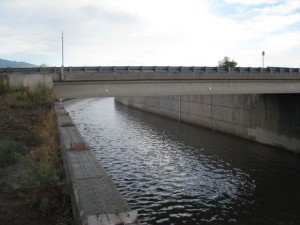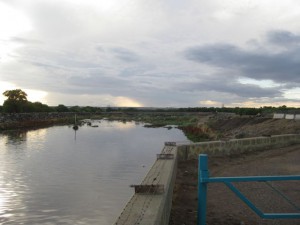We had a nice line of thundershowers move across Albuquerque this afternoon. After dinner, Lissa and I headed to the north end of town to view the results.
The metro area’s North Diversion Channel drains roughly 100 square miles of city, and flood control engineers tell me it’s a relatively unusual terrain for a major urban flood control district, with an unusually large drop from the foothills to the Rio Grande. A series of concrete collector channels gather water from the heights and deliver it to the north Diversion Channel, which starts near my house and goes 8 or 9 miles north until it hits the Rio Grande.
The pictures show the point where it’s nearly reached the river. It’s nasty at this point, having picked up urban detritus large and small. It flares out into a broad shallow holding basin, the purpose of which is to allow the nastiest bits to settle out before the water flows on to the river.
The area in the picture to the right we call the “Tramway Wetlands.” It’s one of those odd bits of accidental urban nature. It’s one of the few broad shallow mud flats along this stretch of the river, and it’s often home to shore birds as a result. (The Rio Grande, with its incised channel, doesn’t offer much in the way of natural “shoreline” any more.) It’s a favorite of local birdwatchers.
At the peak of the flood flow this afternoon, it reached 3,000 cubic feet per second, which for a brief period matches a good spring runoff in the entire Rio Grande.
Here’s a map showing where the pictures were taken:
View Tramway Wetland in a larger map



We are having a discussion on this very issue on Duke City Fix – one question that has come up is whether our storm runoff is as contaminated as those in other areas, such as the Chesapeake Bay, where the difference of fecal bacteria in water samples before and after storm runoff is staggering. Do you have an answer for us, perhaps?
Thanks again for all you do to keep us informed.
BB –
Thanks for paying attention to this issue. I think stormwater contamination is the big, and largely ignored, river pollution story here. Glad y’all *aren’t* ignoring it!
I don’t know about other places, so I can’t compare, but we’ve definitely got fecal coliform (pigeons being the largest source) in our storm water runoff. We also have some potentially serious PCB contamination that looks like it’s coming from the North Diversion Channel. I’ve written big stories about both of these issues over the last year in the Journal.
Send me a link to the DCF discussion and I’ll try to jump in and answer what questions I can.
I used to be amazed at the infrastructure (and at times lack of it) we built here in Tucson to convey stormwater to the dry washes to be moved out of town as quickly as possible. But I’ve evolved over time to view stormwater as less of a nuisance and more of a resource. It is, after all, one of the few local, renewable supplies available in arid areas but has never really been viewed as such. We have a few multi-purpose projects constructed in Tucson in recent years that incorporate flood mitigation, ecosystem restoration, and stormwater pollution reduction – but these are still dwarfed by what has been constructed over the last 60-70 years to simply move stormwater out of the city efficiently.
One other observation from some work I have done with a local non-profit that develops rainwater harvesting projects is that it seems to be much easier to secure grant money to support these projects when they are sold on their stormwater pollution mitigation benefits than on their role in potentially augmenting local water supplies. I’m still trying to puzzle that one out.
Chris – Thanks for the Tucson perspective, that’s useful to understand. Here in Albuquerque, there is a growing sentiment among some of the younger generation in the water engineering community that the concrete-lined, move-it-fast-to-the-river approach is not necessarily the best. Here, though, we face a water rights problem. Our runoff flows into the RIo Grande, and is thus “waters of the state” – part of our overall supply. To the extent rainwater harvesting is successful, it’s depleting flow downstream. Based on the doctrine of prior appropriation, you’re essentially setting yourself up as a very junior appropriator. So it’s problematic. But with a new EPA stormwater permit now in the works, the water quality mitigation has some traction here.
I am amazed at the water level at the Tramway Wetlands. I had wanted to go out there myself, but was really homebound this past week. Was there any sandbars for the shorebirds that are starting to come through?
Thanks for posting the photos and explanation. Although I don’t live in Albuquerque now, I always appreciate knowing more about the waterworks of my hometown.